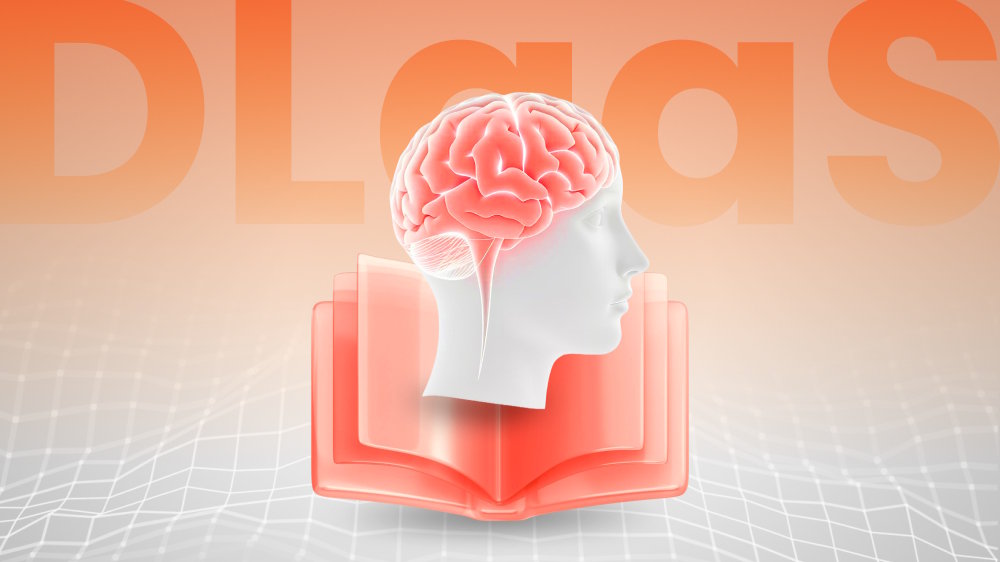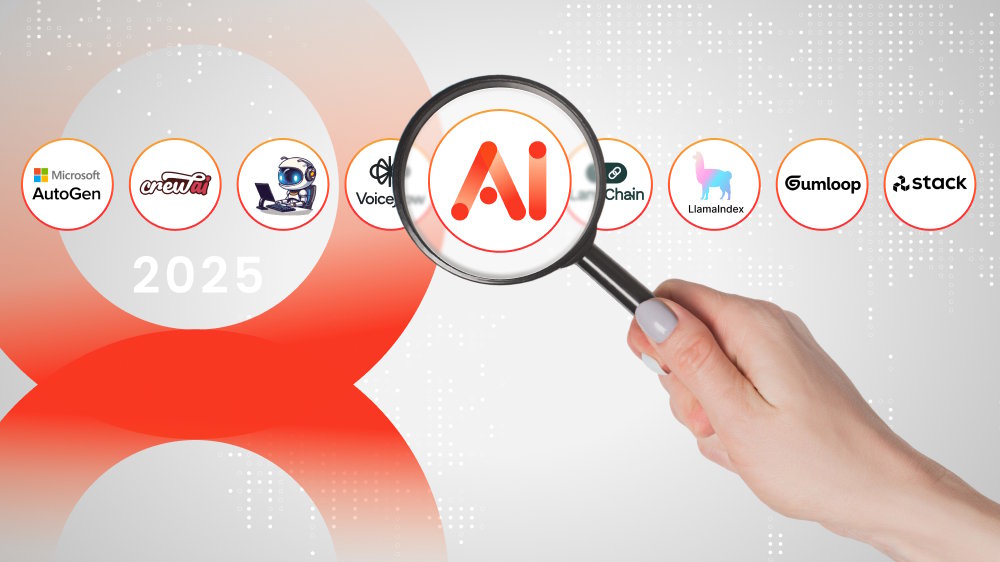
Unlocking BI Success Through Smart Data Integration
Your BI strategy is only as strong as your data foundation. Learn why data integration is the key to transforming raw data into real decisions!

Content Map
More chaptersPeople often call data “the new oil”, or in other words, deem it as a valuable resource. Data lies at the foundation of businesses, enabling them to make informed and confident decisions. Hence, firms must seize new opportunities and adapt to changing market conditions.
However, having data alone is not enough. With business intelligence, firms collect a massive amount of data, in all shapes and forms, from various sources, but don’t know how to utilize it effectively. This often leaves data fragmented and underutilized. To unlock the full value of data, businesses must leverage advanced technologies such as data integration, artificial intelligence (AI), machine learning (ML), and others.
In today’s article, we will focus on data integration and explore how it unlocks true, sustainable success in business intelligence.
Key Takeaways:
- Data integration in business intelligence is the process of unifying multiple data sources for accurate analysis and reporting.
- Data typically comes from multiple, isolated sources, and data integration consolidates all this data into a single source. Beyond this, the process also ensures consistent and accurate data, generating both real-time and predictive insights, all the while improving data governance.
- There are five approaches businesses can take for data integration strategies: ETL, ELT, API Integration, data streaming and data virtualization, depending on the dataset size and the company’s objective.
- As powerful as data integration and BI tools are, to lay the best foundation for these processes, businesses need to ensure data security, stay keenly aware of disparities in data compatibility, and adapt modern solutions to scale with the ever-growing volume of data.
What Is Data Integration in Business Intelligence?
It helps to break down each concept to fully grasp the idea behind data integration in business intelligence.

Data Integration Definition
It is the process of combining and harmonizing data from many different sources into a unified, consistent format to support analysis, reporting, and decision-making. It involves extracting data from diverse systems, such as databases and applications, then transforming and loading it into centralized repositories (data warehouses, data lakes, or lakehouses).
Key components that make up data integration include:
- A variety of data sources that provide raw data.
- Automated data pipelines to ensure data flows efficiently while keeping its integrity.
- Data storage solutions refer to a structured data warehouse or a data lake.
- Data transformation processes turn raw data into a usable format for analytics and reporting.
- Analytics and business intelligence platforms to consume the data for visualization or analysis purposes.
Business Intelligence Definition
Business intelligence (BI) is a technology-driven process for collecting, managing, and analyzing organizational data to support informed decision-making. It combines tools and practices like data analytics, data mining, and visualization to deliver actionable insights that guide strategic planning and day-to-day operations. Modern BI solutions emphasize self-service, data governance, and rapid access to insights, enabling organizations to respond more swiftly to changing conditions and drive continuous improvement.
So, What Is Data Integration in Business Intelligence?
Data integration in business intelligence is the process of unifying data from different sources into a consistent format for accurate analysis and reporting. It enables BI tools to deliver reliable insights and support informed decision-making.
Why Data Integration in BI Matters

Data integration gathers data scattered in multiple sources, so that BI tools can perform analytical and reporting tasks to deliver valuable insights. What other important roles does data integration in business intelligence hold that prompt nearly 100% analytics and IT leaders worldwide to want to get more value out of their data?
Data Integration from Multiple Sources
Every business gathers massive amounts of data every day. The data comes from a multitude of sources – different departments like Marketing, Sales, Operations, different systems like CRMs or ERPs, or from external data suppliers. These siloed data come in all shapes and forms, are stored and analyzed without any particular standards, leading to inefficiencies and redundancies.
Data silos decrease the data value and hinder data strategy success. According to the IBM Data Differentiator, 82% of businesses say that data silos interfere with their vital workflows. Another 68% of company data is left unanalyzed.
Business intelligence tools can’t shine without quality and structured data, so data integration fills in this gap. The process provides companies with the big picture, instead of a single, isolated data aspect.
Consistent and Accurate Data
Having a bigger picture is a great start, but it is not enough. To make sense of the collected data, it must go through a data transformation process of being cleaned up and standardized.
- Data cleaning involves removing any inaccuracy, duplication, incompleteness or irrelevant data. Let’s say the same customer name, Ashley Smith, is entered inconsistently, e.g., “Ashley S.”, “Ashley Smith”, or “Ashley Smit” (with a spelling error), the cleaning process will flag these incidents.
- Data standardization converts data into a uniform format so it can reliably be compared and analyzed. For example, this process will check if all the dates are entered under the same format of “DD/MM/YYYY”, and not “MM/DD/YYY”.
Consistent and accurate data allows business intelligence tools to generate reliable insights.
Timely and Real-Time Decision-Making
Adapting to changing market conditions is one of the most important skills any business must master. However, the lack of visibility data might prevent one from making the right call. Market changes can be volatile, disrupting business operations and affecting the ability to stay relevant or meet customer needs.
While it’s essential to be aware of what is happening, what matters even more is knowing why it is happening. What has led to a specific trend or change in customer demand? What external factors have led to the current market dynamics?
Real-time or nearly real-time data integration in business intelligence gives you the right tools to respond quickly and confidently. Leveraging the right data allows you to seize present opportunities that may never happen again. You no longer need to wait for individual teams to forward reports to make delayed decisions.
Predictive Insights
BI and data integration tools not only give you insight to leverage current opportunities, but they can also give you the tools to predict the future.
Predictive insights matter, as they help businesses mitigate market and operational risks to maintain and sustainable growth, make proactive and strategic marketing decisions, and better manage resources. In addition to data integration processes and BI, most organizations utilize other technologies like AI, ML, data mining, and natural language processing models (NLP) to spot patterns and trends that humans normally overlook.
Encouraging Collaboration
Workplace collaboration is undoubtedly pivotal, as it not only fosters a strong working culture but also improves communication and provides overall better business results.
As we’ve mentioned earlier, each department has its own set of data. Without data integration, each team works with an isolated set of information, leading to unnecessary complications. Insights are inconsistent and may even be conflicting. Teams can’t see the full business picture and are even missing out on valuable opportunities or chances for improvement.
Hence, having a unified vision of the data collected ensures every team operates on a single source. Not only does the data serve every department, from marketing to finance, but it also acts as a single source of truth. Within business intelligence, every team obtains the same insight, and business decisions are more aligned and effective.
Improved Data Governance and Compliance
Healthcare, finance, and the government are strictly regulated industries. Navigating the numerous laws and regulations can be challenging. Failing to comply with them leads to expensive fines.
The mountain of data from these sectors adds another layer of challenge for organizations. However, with data integration and business intelligence tools, they can:
- Have centralized control by consolidating data into a single system, where it is easier to apply data governance policies consistently.
- Trace where data comes from, how it has been transformed and used, and what teams have access. This supports audit trails and complies with regulations like HIPAA or GDPR.
- Enhance security with integrated data pipelines.
Key Data Integration Strategies for BI Success
There are five key data integration strategies to achieve success in BI.
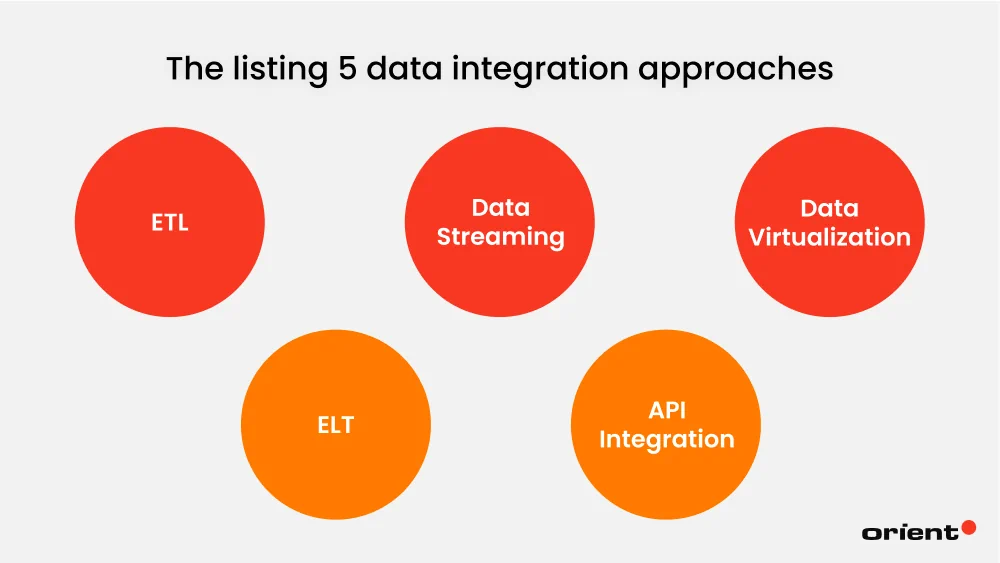
ETL
ETL stands for extract, transform, and load.
- Extract refers to the data collection process. Data can be collected from various sources, consisting of web services, databases, API, and data streams. Data is temporarily stored before processing.
- Transform involves converting data into a standardized format that is best for usability. The process cleans, validates, and enriches data for specific goals.
- Load moves the data into a specific storage, like a data lake, data warehouse, or database. This process might entail extra steps for validation and verification before committing the data to storage.
ELT
ELT stands for extract, load, transform.
- Extract in ELT is similar to ETL, where both structured and unstructured data are exported or copied. Before moving, the data is in a staging area, where it needs to be confirmed for integrity and applied to business rules.
- Load entails moving data into a targeted repository, e.g., a cloud data warehouse.
- Transform is where the data is converted into a format or structured to suit the target system’s usability.
The main difference between ETL and ELT is when the transformation occurs. To simplify when to use which method, ETL is more suitable for large datasets, and ELT is a better choice for small datasets.
Data Streaming
Data streaming is the real-time process of collecting, processing, and delivering continuously generated data from sources (log files, servers, or IoT sensors). Data streaming integration handles data the very moment it arrives, unlike the traditional approach of batch processing. As a result, users gain immediate insights and can generate timely actions. Data streaming is ideal for cases such as fraud detection or customer experiences.
API Integration
API (application programming interface) integration involves the connection between software systems to create a seamless and real-time data exchange. It acts as a bridge between applications, which allows the apps to communicate, sync data, and automate workflows. To ensure accurate and reliable communication between two systems, the data sets between them need to be unified and consistent.
Data Virtualization
Data virtualization provides a flexible way to access and integrate data from many different sources without physically moving it. Unlike the previous approaches, data virtualization creates a virtual layer that connects various systems, e.g., databases, cloud apps, and delivers a unified view in real time, instead of concentrating data in a single location. While maintaining the source data at its location, this approach simplifies integration by allowing users to query and combine data on demand.
Use Cases of Data Integration in BI
There have been many concepts thrown around in the article. To better understand what they look like in real life, here are some specific case studies.

Big Data Integration
Big data refers to a massive amount of structured, unstructured, and semi-structured data that traditional systems have trouble managing. BI is the essential tool to extract, analyze, and make sense of such information. However, as big data typically comes from multiple disconnected sources, BI tools struggle with raw, unstructured, or high-velocity data.
This is where data integration comes in. It brings together the fragmented data into a unified view for analyzing, reporting, and visualization. Without data integration, it can be difficult for BI tools to turn data into actionable and meaningful insights.
Healthcare
Data integration plays a critical role in ensuring the effectiveness of business intelligence in the healthcare industry. By connecting patient records from different departments, hospitals, and care providers, organizations can create a complete, up-to-date view of each patient’s medical history. Doctors have the full picture they need to make smarter, faster treatment decisions.
Data integration is also valuable in broader BI tasks, like analyzing public health trends. By analyzing data from multiple labs, clinics, and government agencies, BI can spot patterns quickly. It can quickly detect signs of a disease outbreak, so medical officials can quickly act and guide the public.
Financial Services
Within the context of business intelligence, data integration allows financial institutions to consolidate data from siloed systems, such as customer accounts, transaction logs, and risk management platforms, into a centralized, consistent dataset. This lays out the foundation for BI tools to perform real-time analytics, detect anomalies, and generate dashboards.
Let’s take detecting anomalies, or fraud detection, as an example. BI systems leverage integrated data to analyze customer behavior, transaction patterns, and historical activity side by side. This allows teams and automated systems to flag suspicious activities in a fast and accurate manner.
Another instance is regulatory compliance. To ensure compliance, data integration feeds accurate and high-quality information into BI reports and audit trails.
Data Integration Challenges
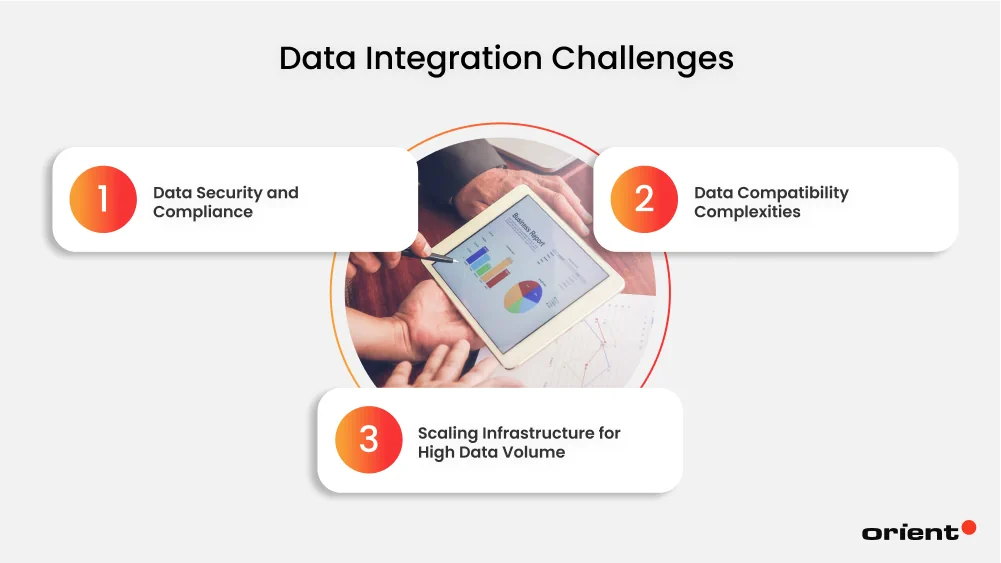
Data Security and Compliance
Data safety should always stay as one of your top concerns. Since data integration consolidates multiple sources into a centralized system, it also brings together a wide range of security risks. The security and compliance concerns are magnified as it is harder to ensure data’s compliance, integrity, and confidentiality.
Companies must implement rigorous access controls and encryption measures while keeping a close eye on the system to quickly handle anomalies or data breaches.
Data Compatibility Complexities
We have repeatedly mentioned that the data fed into BI needs to be transformed for optimal usability. However, data compatibility is tricky, as they come from disconnected sources (CRM, third-party apps, cloud platforms) with all kinds of structures and formats. Every small difference is a challenge to the BI system, e.g., different naming conventions, measuring units, or data types.
Due to the variety in data format, it can be difficult to merge the data into a single usable and consistent format. Even though there are multiple strategies to transform data into an accurate and consistent dataset, disparities in the dataset can sometimes be inevitable.
Scaling Infrastructure for High Data Volume
Traditional BI tools might have trouble keeping up with the ever-increasing data volume. Even with proper preparation and data transformation from data integration processes, BI tools can still struggle under the mountains of datasets, leading to slower performance, unwanted delays, and bottlenecks.
This problem asks organizations to adopt modern, scalable integration solutions that can handle growing data loads without sacrificing performance. This can be achieved through solutions like cloud-native infrastructures or stream-based pipelines to keep the BI system accurate and scalable.
Best Practices for Data Integration in Business Intelligence
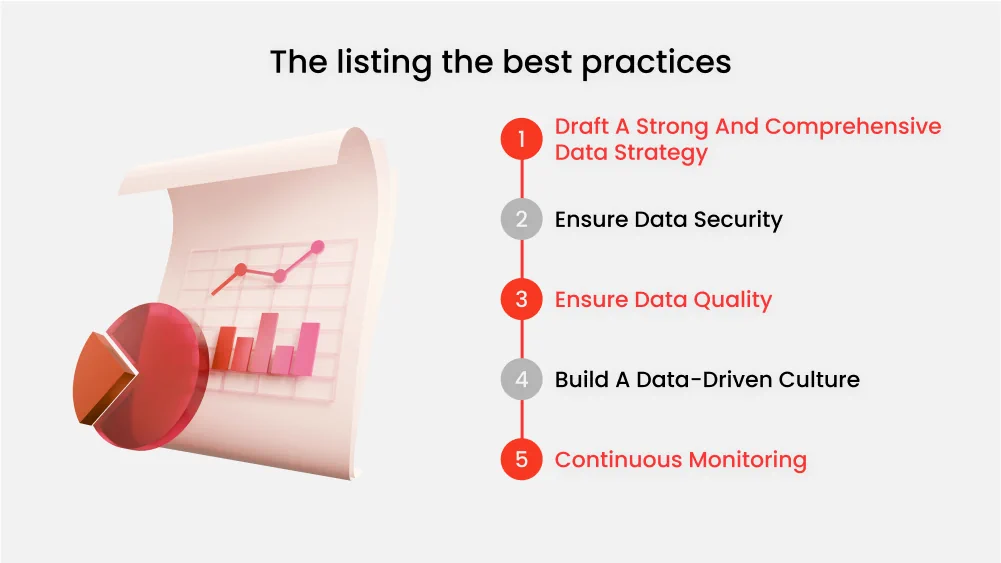
Data is the new oil, which is why data integration in BI is such a powerful tool. However, to truly leverage these valuable resources, there are five practices you need to keep in mind in order to yield the best results.
- Draft a strong and comprehensive data strategy. Identify the objects you want to achieve with data integration in BI. Ask yourself and your team why those goals matter to you. Setting clear goals is how you guide the rest of the business strategy, stay aligned with business objectives, while maximizing the value of your data.
- Ensure data security. Security and privacy are essential for building and maintaining trust with clients and customers. Implementing a robust framework to protect data integrity not only supports accurate, reliable BI insights but also reinforces your organization’s credibility. By prioritizing security, privacy, and data quality, you create a foundation that benefits both your business intelligence efforts and your customer relationships.
- Ensure data quality. Always prioritize quality over quantity. It is the quality of the data that generates deep, meaningful insights for your business. Make sure to thoroughly clean, standardize and enrich your dataset to set a strong and reliable foundation for the BI system.
- Build a data-driven culture. Hold workshops and training sessions to help your team truly understand the value of data. Teach your team how to utilize data efficiently to lead to success and valuable insights. When your vision and strategy resonate with the rest of the team, you’ll gain support and further enrich the BI process.
- Continuous monitoring. Be on a constant lookout for methods to improve current processes. Establish KPIs to benchmark the results. Data is constantly evolving, and so should your strategies.
Wrapping Up

Meaningful data holds the power to transform your entire business strategy, which is why it’s paramount for you to understand and leverage the right tools and strategies. However, it’s also just as important to keep in mind the challenges that come with it and how to solve them effectively.
Another thing to keep in mind is that you don’t have to navigate data integration in business intelligence alone. Orient Software can be your partner in finding the best data strategies and how to implement them, all while keeping data integrity and quality. Don’t hesitate to reach out to us today!

